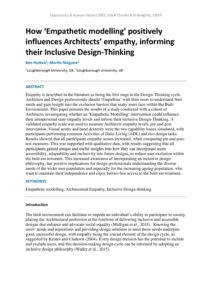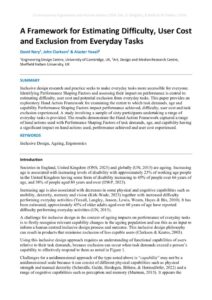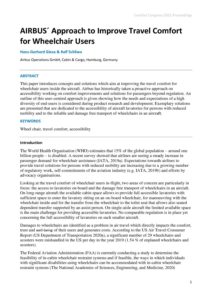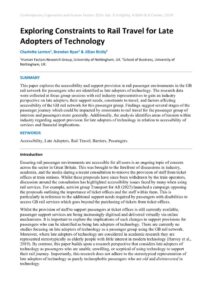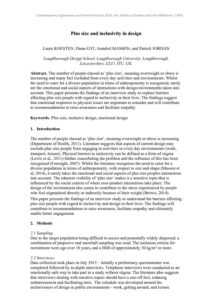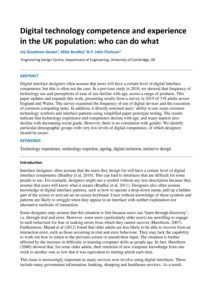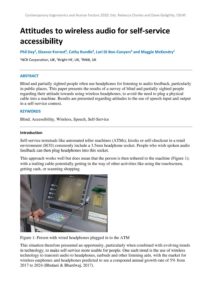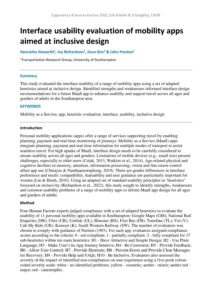Accessibility
How ‘Empathetic modelling’ positively influences Architects’ empathy, informing their Inclusive Design-Thinking
| Document | Author Kim Hutton and Martin Maguire |
| Abstract Empathy is described in the literature as being the first stage in the Design-Thinking cycle. Architects and Design professionals should ‘Empathise’ with their users to understand their needs and gain insight into the exclusion barriers that many users face within the Built Environment. This paper presents the results of a study conducted with a cohort of Architects, investigating whether an ‘Empathetic Modelling’ intervention could influence their intrapersonal state empathy levels and inform their inclusive Design-Thinking. A validated empathy scale was used to measure Architects empathy levels, pre and post intervention. Visual acuity and hand dexterity were the two capability losses simulated, with participants performing common Activities of Daily Living (ADL) and two design tasks. Results showed that all participants empathy scores increased, when comparing pre and post-test measures. This was supported with qualitative data, with results suggesting that all participants gained unique and useful insights into how they can incorporate more accessibility, adaptability and inclusivity into future designs, to reduce user exclusion within the built environment. This increased awareness of incorporating an inclusive design philosophy, has positive implications for design professionals understanding the diverse needs of the wider user population and especially for the increasing ageing population, who want to maintain their independence and enjoy barrier-free access to the built environment. |
A Framework for Estimating Difficulty, User Cost and Exclusion from Everyday Tasks
| Document | Author David Nery, John Clarkson & Alaster Yoxall |
| Abstract Inclusive design research and practice seeks to make everyday tasks more accessible for everyone. Identifying Performance Shaping Factors and assessing their impact on performance is central to estimating difficulty, user cost and potential exclusion from everyday tasks. This paper provides an exploratory Hand Action Framework for examining the extent to which task demands, age and capability Performance Shaping Factors impact performance achieved, difficulty, user cost and task exclusion experienced. A study involving a sample of sixty participants undertaking a range of everyday tasks is provided. The results demonstrate the Hand Action Framework captured a range of hand actions used with Performance Shaping Factors of task demands, age, and capability having a significant impact on hand actions used, performance achieved and user cost experienced. |
AIRBUS´ Approach to Improve Travel Comfort for Wheelchair Users
Exploring Constraints to Rail Travel for Late Adopters of Technology
| Document | Author Charlotte Lenton, Brendan Ryan & Jillian Rickly |
| Abstract This paper explores the accessibility and support provision in rail passenger environments in the GB rail network for passengers who are identified as late adopters of technology. The research data were collected at focus group sessions with rail industry representatives to gain an industry perspective on late adopters, their support needs, constraints to travel, and factors affecting accessibility of the GB rail network for this passenger group. Findings suggest several stages of the passenger journey which could be impacted by constraints to rail travel for the passenger group of interests and passengers more generally. Additionally, the analysis identifies areas of tension within industry regarding support provision for late adopters of technology in relation to accessibility of services and financial implications. |
Plus size and inclusivity in design
| Document | Author Laura KOESTEN, Diane GYI, Annabel MASSON, and Patrick JORDAN |
| Abstract The number of people classed as ‘plus size’, meaning overweight or obese is increasing and many feel excluded from every day activities and environments. Whilst the need to cater for a diverse population in terms of anthropometry is recognized, rarely are the emotional and social aspects of interactions with design/environments taken into account. This paper presents the findings of an interview study to explore barriers affecting plus size people with regard to inclusivity in their lives. The findings suggest that emotional responses to physical issues are important to consider and will contribute to recommendations to raise awareness and facilitate empathy. |
Digital technology competence and experience in the UK population: who can do what
| Document | Author Joy Goodman-Deane, Mike Bradley and P. John Clarkson |
| Abstract Digital interface designers often assume that users will have a certain level of digital interface competence, but this is often not the case. In a previous study in 2010, we showed that frequency of technology use and perceptions of ease of use decline with age, across a range of products. This paper updates and expands this work, presenting results from a survey in 2019 of 338 adults across England and Wales. The survey examined the frequency of use of digital devices and the execution of common computing tasks. In addition, it directly assessed users’ ability to use some common technology symbols and interface patterns using simplified paper prototype testing. The results indicate that technology experience and competence decline with age, and many aspects also decline with decreasing social grade. However, there is no correlation with gender. We identify particular demographic groups with very low levels of digital competence, of which designers should be aware. |
Attitudes to wireless audio for self-service accessibility
| Document | Author Phil Day, Eleanor Forrest, Cathy Rundle, Lori Di Bon-Conyers and Maggie McKendry |
| Abstract Blind and partially sighted people often use headphones for listening to audio feedback, particularly in public places. This paper presents the results of a survey of blind and partially sighted people regarding their attitude towards using wireless headphones, to avoid the need to plug a physical cable into a machine. Results are presented regarding attitudes to the use of speech input and output in a self-service context. |
Interface usability evaluation of mobility apps aimed at inclusive design
| Document | Author Henrietta Howarth, Joy Richardson, Jisun Kim & John Preston |
| Abstract This study evaluated the interface usability of a range of mobility apps using a set of adapted heuristics aimed at inclusive design. Identified strengths and weaknesses informed interface design recommendations for a future MaaS app to enhance usability and support travel across all ages and genders of adults in the Southampton area. |
Improving access to Magnetic Resonance Imaging (MRI) examinations for people with disabilities
| Document | Author Jon Mason, Joshua Fox & Kiki Veenhof |
| Abstract For people with disabilities, accessing healthcare services can be problematic, uncomfortable and potentially unsafe. Whether it is situational, temporary or permanent impairment, disability can affect everyone. When the healthcare company Philips Healthcare embarked on designing their next generation MRI machines, we, the human factors team, applied an inclusive design approach from the outset. In this paper, we will share details of a research study we conducted into how people with disability currently experience MRI. Data were collected via qualitative online interviews, with ten participants experienced disabilities from the UK. The findings showed that access to MRI radiology is an uncomfortable experience, both physically and cognitively. Accessibility issues were found throughout the process from travelling to the appointment, preparing for the scan, accessing and exiting the MRI machine. The general findings from the study are shared and recommendations for how to improve access to MRI radiology are presented. |

